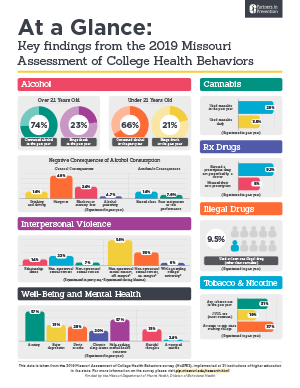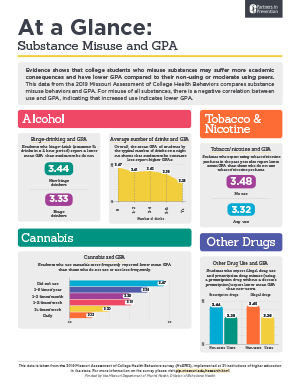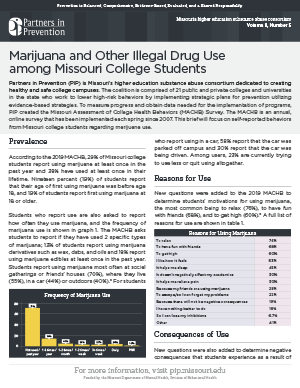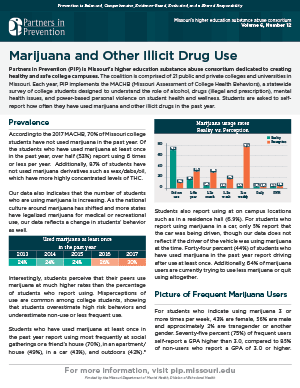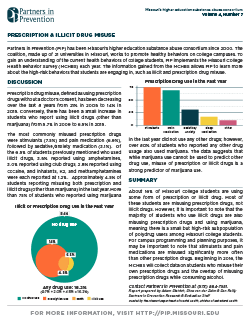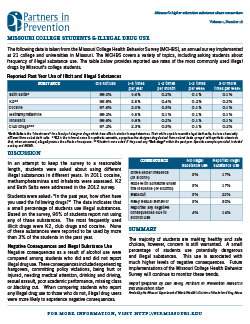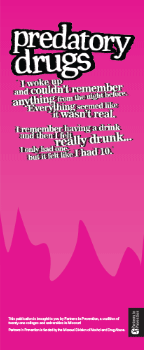
Illegal Drugs

Drug use among college students is prevalent, due to factors such as increased freedom, unstructured free time, and perceived norms of college life.
However, drug use is associated with adverse academic and health outcomes and risks to personal safety, and is a significant public health concern. Compiled here are resources related to drug abuse prevention among college students.
Scope
National Data
Nationwide rates of use in the past year among college students are as follows:
Amphetamines
Tranquilizers
MDMA
Cocaine
LSD
Synthetic
Marijuana
Heroin
Sedatives
Methaqualone
Inhalants
Nationwide rates of use in the past year among college students are as follows:
- Of those students who reported drug use, almost half (44%) had driven a car while on drugs, approximately one-third reported preoccupation with drug use or trying to limit or stop use, and one-quarter had taken more drugs than they planned or had used during school or work
- On average, males use illicit drugs at higher rates than females
- Peak age of illicit drug use among college students is ages 21-22
- Prevalence of use for most illicit drugs among college students is lower compared to use among their non-college peers
Missouri Data
In the past year, Missouri college students report rates of use as follows:
Hallucinogens
Cocaine
Synthetic
Marijuana
Amphetamines
Club
drugs
Inhalants
Meth-
amphetamines
Heroin
*2017 MACHB data as certain questions are cycled in and out*
Data Briefs
Click on a brief below for more information.
At a Glance
Volume 8
Volume 6
Volume 4
Volume 1
Best Practices
Quick Links
Evidence Based Educational Programming | Enforcement of Laws and Policies | Detection and Early Intervention of Substance Misuse DisordersEvidence Based Educational Programming
Effective educational programming includes the following elements:
- Increases students’ knowledge regarding the effects and the potential safety, health, social, academic and legal consequences of drug misuse
- Increases awareness regarding the signs and symptoms of drug misuse and dependency
- Assists students in evaluating their expectations regarding, and motivations for drug use
- Provides training in stress management, resistance skills and media literacy
- Assists students in exploring alternatives to drug use for socializing, destressing and celebrating
- Assists students in knowing how to help a friend in trouble
- Corrects misperception regarding norms for drug use at their institution
- Provides students with information about campus and community alcohol and other drug prevention, student assistance, and wellness and health promotion resources
Enforcement of Laws and Policies
- SAMHSA has a great webinar on the role of law enforcement in preventing substance misuse on college campuses
Detection and Early Intervention of Substance Misuse Disorders
- Screening, Brief Intervention, and Referral to Treatment (SBIRT) is an early intervention approach that is being used in colleges nationwide
- The Community Prevention Initiative has a good guide on effective substance misuse prevention
- The SHADE (Self-Help for Alcohol and Other Drug Use and Depression) Computer Delivered Treatment may be a promising intervention to reduce substance use disorders. More information about SHADE can be found here
National Resources
- National Institute on Drug Abuse
- SAMHSA Behavioral Health Treatment Services Locator
- Addiction Resource
- Addiction Recovery
- Get Smart About Drugs: getsmartaboutdrugs.gov
- Drug Abuse Hotline: 1 (877) 801-7284
- SAMHSA’s National Helpline: 1 (800) 662-4357
Research
Relevant Research Articles
- Monitoring the Future: Key Findings on Adolescent Drug Use (2016)
- Prevalence and incidence of drug use among college students: an 8-year longitudinal analysis
- Prevention and treatment of college student drug use: a review of the literature
- Drug use patterns and continuous enrollment in college: results from a longitudinal study
